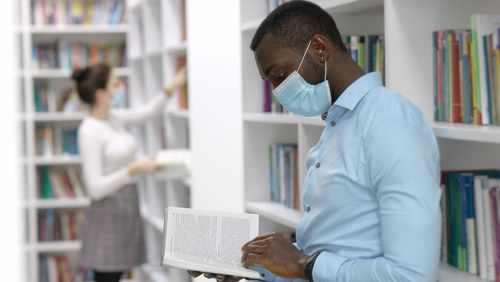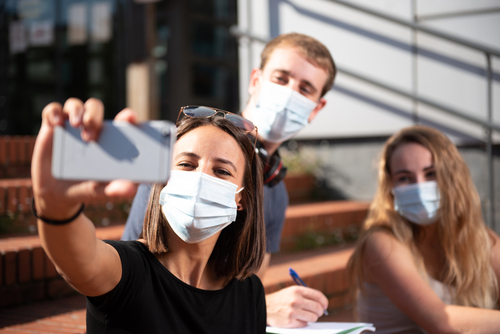How The Coronavirus Pandemic May Change College Forever
Find your perfect college degree

“Don’t come back to campus.”
This official instruction from colleges and universities across the United States didn’t exactly come as a surprise, given the deadly coronavirus pandemic. But it was certainly a scenario, not anyone would have expected.
Besides significantly affecting the tourism, travel, and food industries, the pandemic certainly took a toll on the education sector.
College Closures, Challenges, and Responses
The closures started in Washington state, the location of COVID-19 patient zero in the United States. Eventually, hundreds of colleges and universities announced cancellations and suspended student travel programs.
Nearly all countries enforced localized or country-wide school closures, disrupting 89% of all students anywhere in the world across all education levels.
The COVID-19 crisis highlighted the plight of 86% of college students who suffered from food or housing insecurity and heightened incidents of discrimination.
Helping mitigate these issues were these efforts:
- Student-focused groups raised funds to drive financial help to students in need.
- Colleges and universities provide guidance in navigating academic adjustments and getting the help they need.
- The National Collegiate Athletic Association provided relief for student-athletes amid cancellations of athletic tournaments.
- The Office for Civil Rights at the U.S. Department of Education urged colleges and universities to ensure that “no student is discriminated against based on race, color, or national origin.”
- Dramatic Shifts in Admissions and Academic Affairs
Colleges and universities were forced to adapt to the crisis:
- The college admissions process involved virtual tours instead of campus tours for incoming college.
- Admission deposit deadlines were postponed to a later date.
- Commencements and other critical academic events were widely canceled.
- Senior medical students were allowed to graduate early, with permission and guidance from the American Medical Association, in an effort to strengthen the health care reserve.
A related survey by Art & Science Group LLC revealed that college-bound high school students nationwide were rethinking their higher education plans.
With reduced enrollment and retention rates looming, colleges and universities feared long-term financial shocks.

$14.3-Billion Federal Fund for Higher Education
Of the federal government’s $2.2 trillion Coronavirus Aid, Relief, And Economic Security (CARES) Act, $14.3 billion was intended for higher education relief/
Part of this Education Stabilization Fund covered the Federal Student Aid office’s “relief…during the COVID-19 national emergency” for borrowers. Federal student loan payment deadlines were suspended, and the interest rate was temporarily dropped to 0% for specific loans.
The National Governors Association called for the immediate distribution of the Education Stabilization Fund to address the needs of the elementary, secondary, and higher education communities and students.
How College Students Self-Regulated Online Learning During the Pandemic
Experts believed the existence of distance learning technologies—however inadequate—played a pivotal role in the higher education sector’s response to the pandemic.
About 81% of colleges and universities across America migrated to online learning or remote classes entirely for the rest of the academic term.
Most, however, were inadequately unprepared. Others lamented how virtual instruction was, and still is, no substitute for actual laboratory work and experiential learning.
On the flip side, online learning proved to be a promising alternative, as learners and educators were “forced” to upskill themselves and integrate the components of machine learning, data science, and artificial intelligence into their areas of study.

Moving On: The Impact of Covid-19 on College Learning Today
The end of the COVID-19 pandemic is in sight, according to the World Health Organization. The global rollout of vaccines and therapies helped communities fight against the virus that caused at least 6 million deaths. Some COVID-19 variants emerged, but the effects have been less severe.
As online college becomes the norm, US universities leverage online learning to expand their global reach, utilizing state-of-the-art online platforms that connect students from around the world. Online education may already be part of most college and university programs across the globe, but moving all programs online continues to be a challenge, particularly for small, struggling universities.
Did Online Learning During the Pandemic Dampen the College Spirit?
The exact impacts of distance learning, which most students around the world took longer than one year to complete, remain unclear. According to previous studies, students’ academic performance in the United States declined throughout the pandemic, and individuals with developing skills stopped improving.
As young people could be asymptomatic carriers of the disease, they worried about the possibility of contracting the virus and putting their older family members at a greater risk. A constant fear of infection, the length of quarantine, frustration, boredom, and inadequate supplies and information were all major stressors for college students.
Unlike face-to-face education, online learning environments propelled reduced collaboration among and demotivated many college students who had to deal with uncertainty amid abrupt educational disruptions and graduation delays. Commonly reported issues were anxiety, depression, family problems, stress, alienation, isolation, and a crumbled sense of confidence.
New Positive College Student Habits and Emerge
A Tec Review survey saw 88% of college students saying they “liked” the distance-learning format. It is estimated that 81% of the students improved their self-study skills and developed independent study habits.
A significant improvement was also reported in digital literacy. According to the survey, 83% said distance learning improved their ability to use technology, and 82% said educators explored the use of technology in the classroom.

Hybrid Could Be the Future
Our understanding of work and learning has changed over the past few years. There has been a significant shift in attitudes toward in-person learning and work in recent years.
Leaders and educators from across the globe have demonstrated an incredible amount of commitment and flexibility as they respond to the need for remote learning in the past year and more. Governments, schools, universities, and students alike have welcomed the idea of reopening campuses and schools as the world learns to live with uncertainty.

Although digital learning has many advantages, in-person education is ideal as well. Hands-on learning is still the best way to acquire some skills and knowledge. Therefore, the hybrid learning model combines the best of both worlds for today’s higher education institutions, owing to these facts:
- Hybrid learning is characterized by flexibility. Modern-day students juggle multiple personal and job commitments and find that this alternative format fits their lifestyle and needs. In some cases, working at their own pace and on their own terms is also beneficial to the learner.
- Student freedom of choice is one of the benefits of hybrid learning.
- Educators and educational institutions can use resources more efficiently and communicate more effectively. All these and more reasons make hybrid learning an ideal mode of learning option for most college students.
If there’s one thing the coronavirus pandemic taught the education sector, it is to prepare for the worst. Perhaps the real challenge for colleges is implementing virus-mitigating measures to deal with new COVID-19 variants. Should an uptick in diseases occur, colleges should have a plan in place to minimize disruption and maintain the quality of college education to produce skilled professionals.
Additional Information:
